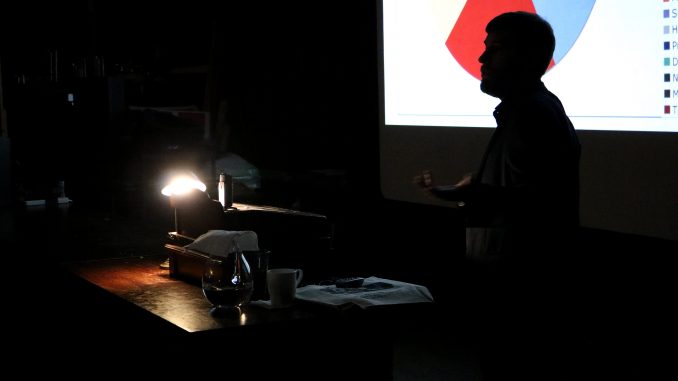
As a child, Kristofer Helgen developed an interest in wildlife beyond juvenile infatuation—at 12 years old, he had already memorized the Latin name of almost every known mammal.
“For me, it was more than just an interest in animals or something like that, it was especially a fascination with variety and this concept of, ‘How many kinds of animals are there?’” Helgen said. “I almost learned mammalogy like a kid would learn a second or an additional language. I learned it at such a young age that it’s just part of my brain.”
Today, Helgen works as curator of the division of mammals at the Smithsonian National Museum of Natural History in Washington, D.C. Helgen examines archived specimens in natural history museums to find mislabeled or overlooked species. He also applies his extensive scientific knowledge—which includes a bachelor’s degree in biology from Harvard University—to uncover previously unidentified species.
He has identified nearly 100 new mammal species, like a member of the raccoon family called the olinguito—the first carnivore species discovered in the Western hemisphere in nearly four decades.
Last Saturday, Helgen came to the Wagner Free Institute of Science at the corner of Montgomery Avenue and 17th Street to deliver a public presentation on his work. The visit was part of the institute’s annual Westbrook lecture series, which focuses on different scientific themes each year.
Helgen said preserving natural life through collections like the Wagner’s is as essential as it is fascinating.

“It’s a little bit like a coin that’s taken out of circulation 100 years ago, just put in a safe place and looked after, and in 2016 you go and look at it and it’s shiny, and it’s wonderful and it’s this thing from a bygone era,” he said. “These specimens are like that, too, except they’re not coins. They’re physical specimens. That’s remarkable because the chemistry and the biology that made up that creature 100 years ago is still there to be had.”
“Every specimen in a museum is a little time machine that takes us back to the time and place where it was collected,” he added.
Wagner director Susan Glassman, who has been with the institute since 1992, reached out to Helgen because she believes his research matches this year’s Westbrook series’ theme of historical zoological collections.
“He’s so articulate about why the nature of collecting is important and why keeping older collections is important and what we can learn from them,” Glassman said. “I think a lot of times people don’t realize that even things collected in the past still can inform contemporary scientific research.”
Although the lecture was Helgen’s first time at the Wagner, he is no stranger to Philadelphia’s biology collections. In 2006, Helgen visited the Academy of Natural Sciences of Drexel to explore its archives.
Within his first hour at the academy, he identified an undiscovered extinct species of flying fox by examining a mislabeled 160-year-old Samoan bat specimen.
“There’s a particular tragedy to a story like that because that’s an animal that, 150 years ago, was there,” Helgen said. “We’d be blind to the fact that it ever existed if someone hadn’t taken the remarkable effort to collect that specimen, save its skull, put its skin in a jar and not just that, but look after it for more than 150 years.”
2013 geology alumnus Aaron Lawson, a children’s educator at the Wagner, sees value in natural historical archives as well as early science education.
“It’s science, and science is always changing,” Lawson said. “I don’t ever view something as ‘the one correct answer’ because everything is changing. Every species is kind of a transitional species, so you never know what people can miss, especially if you’re looking into historic collections like at the Wagner of even at the Academy [of Natural Sciences]—institutions that have been in place since the 1800s.”
“I think the younger the people we can impact, the better,” he added.
When Helgen isn’t sifting through archives, he’s out on field research expeditions—which do not come without their dangers. During his first expedition in Botswana, when he was only 19, he failed to notice the sun setting behind him.
“It got quite dark, and I heard something behind me … and I turned around and there was a lioness there,” he said. “She was no more than maybe 15 feet away from me.”

Helgen worries the biggest threats facing biology collections are low funding for museums and public attitudes that view natural history collections as “things of the past.” He also believes these collections are an “untapped resource” for assessing modern environmental issues like climate change.
Despite his achievements, Helgen emphasizes that the natural world still leaves much for researchers to discover.
“The fact that this still happens in groups like mammals as well as things like trees and birds, these kinds of groups that we think should be so well known, that really illuminates, I think for all of us, how little we know about our planet still, and how much there still is to learn,” he said.
Eamon Dreisbach can be reached at eamon.noah.dreisbach@temple.edu.


Be the first to comment